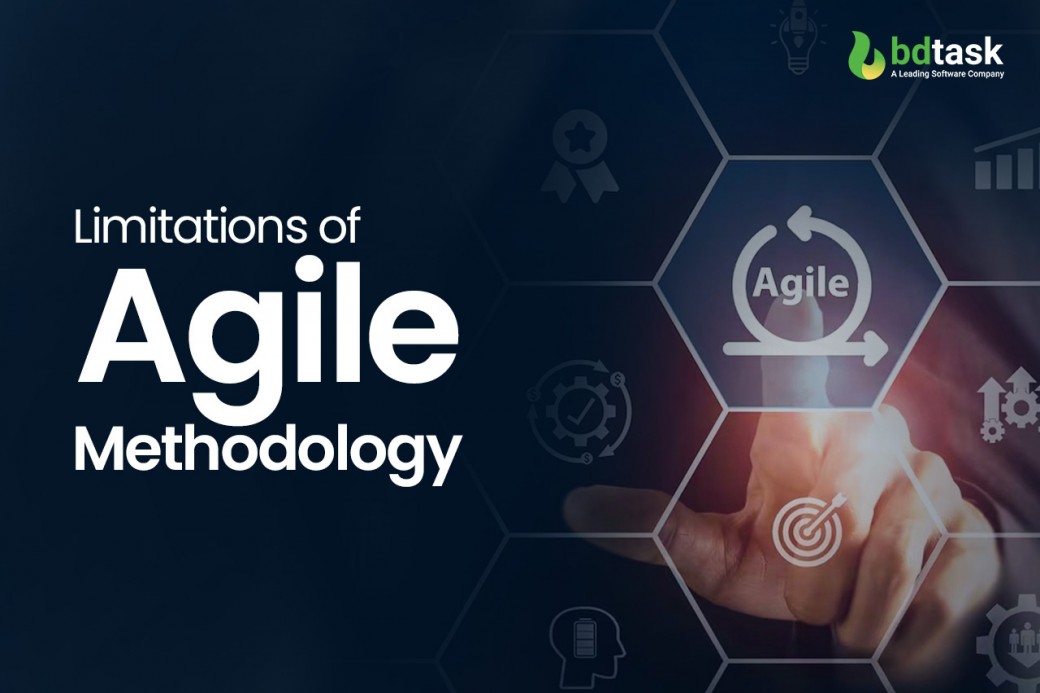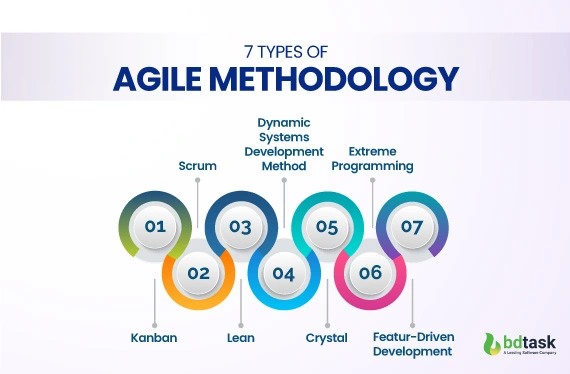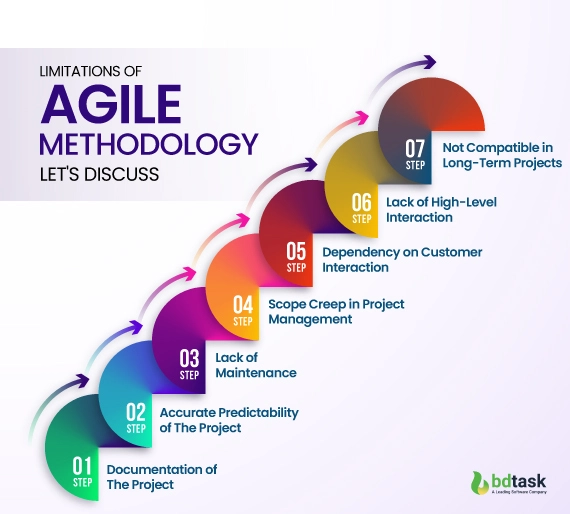Limitations of Agile Methodology in Software Development

Every SDLC model has its advantages and disadvantages. The agile method is most popularly used in development methodologies in today's world. If you want to use it for your product implementation, then the limitations of agile methodology should also be remembered.
Indeed, agile methodology is used in 97% of organisations. Undoubtedly, the usage ratio of this project management methodology is better than the other method of SDLC. But checking the limitations is always important to ensure a successful project campaign.
In this blog, we review the limitations of agile methodology as well as other aspects of this model. This blog will help to get a better idea of this model so that you can learn the cons of this project before using it.
So, start fresh.
What Is Agile Methodology in SDLC
Agile methodology is a project management model framework. Its complete process in several steps includes planning, Design, development, testing, deployment and review. It works in different stages, and all those steps are called sprints.
Indeed, it works like an interactive method, which helps to reduce risk, manage efficiency, and approach problems more flexibly and dynamically. Basically, it manages to break large-scale projects into small iterations, and at the end of the project, it maintains a quality output. Indeed, some of the sectors that help the agile model make a real difference include :
- Software Development
- Leadership and Management
- Product design
- Marketing
Before proceeding to the limitations of agile methodology, let's talk about the different types of agile methodology.
7 Types Of Agile Methodology

The agile framework is not just a one-size-fits-all solution. It depends on the variation of the project requirements. There are various types of agile methodologies in this framework. Each type has its style to implement the product outline. So, before proceeding with any of these methods, check your requirements first and choose the one type. Let's check some of those types :
1. Kanban
Kanban = Continuous improvement
It originated at Toyota in the 1950s as a production control system.
It basically works like visualising the entire project in its Kanban board. This type of model is really known for its flexibility, like no more rushing for a deadline. People who are working in this model customise the project timetable based on their bandwidth and priorities. This Kanban agile methodology is suitable for a highly adaptable project.
The most important part of this method is that it is complete and manages all the work in three different columns (Todo - Doing - Done ). But there are also some limitations in using this method, like general resistance to change or lack of task clarity, etc.
2. Scrum
Kanban and Scrum have some similarities. The similarity is that two of these methods use a Scrum board. It was generally found in 1986 and its used in complex projects. It promotes collaborative work like teamwork, adaptability and transparency. The Scrum method works like short iterations. This short iteration is called a sprint. It typically lasts one to four weeks. However, each sprint team delivers small, tangible pieces. This small, tangible piece helps to prioritise flexibility and responsiveness, and it leads to quality products in the end. The main motto of this Scrum method is client satisfaction.
It's best for IT and the global software development sector for project-related work. The main limitation of this method is that you get what you want in your project, but the estimated cost is not fixed. Sometimes, it's really tough to manage and make plans, structure, and organise a project. This burdens the project owner and sometimes costs a huge amount of money.
3. Lean
It's a method that helps minimise waste and maximise the project's efficiency. The main goal of this model is to improve the overall efficiency and reduce the waste of the project. It's not only the minimisation of the waste but also maintaining efficient processes while bringing a quality product. Lean methodology also has some principles, like the waterfall model.
The principle of this methodology
- Customer satisfaction
- Try to be true to their commitment
- Fast delivery
- Total optimisation of the project
- Focus on high-quality output
It's suitable for those who are focused on quality, efficiency and productivity.
4. Dynamic Systems Development Method (DSDM)
DSDM is another method of the agile model in software development. It was created in 1994. It's kind of suitable for any kind of project, like small, medium or large. It's basically a vendor-independent project. It basically covers the entire lifecycle of a project and provides best practice guidance for on-time delivery. The principle of this project is :
- Build incrementally from the start of the project
- Develop iteratively
- Communicate continuously and clearly
- Demonstrate control
- Focus on the business requirements and needs
- Deliver the project on time
- Collaborate with a teammate
- Try to give the best quality
It's suitable for a corporate setting as well, where it's kind of challenging to implement the agile tools.
5. Crystal
It's a lightweight methodology, and its focus is on the individuals and the interactions of the projects. It's a combination of different tools like crystal red, yellow, orange and red. Each version of this colour code has its requirements. It's usable based on their team project and the requirements. Suppose Crystal Clear is suitable for a small project which a team includes 6 developers. On the other hand, Crystal Red is suitable for a large kind of project which includes around 60-70 developers.
The two benefits of this crystal method of agile methodology. The one is to find your own way and method to optimise the workflow. The other one is to make the project unique and more dynamic.
Properties of this model
- Frequent delivery
- Customer satisfaction
- Incremental development
- Automate testing
- Easy access to an expert user
6. Extreme Programming (XP)
This model is the ultimate goal to develop highly efficient software and to maintain a higher quality of life for the development team. It's the most specific type in this agile model. In this process of development, the work continues planning, testing and customer satisfaction. It leads to giving the best possible output for the software development project. This model, has five core values included
- Courage
- Respect
- Communication
- Simplicity
- Feedback
This model is applicable when
- Dynamically challenging software development.
- Fixed time project
- Automated units and Fun sectional tests.
- Web development project
- Collaborative project
- A project with rapidly changing requirements
7. Feature-Driven Development (FDD)
This model maintains stricter documentation than the XP model. It was formally discussed in 1999 in a book called Java Modelling in Colour with UML. This model is introduced to the public because of the five-step development process :
- Develop the entire model
- Build the feature list
- Plan by feature project development
- Design by feature project development
- Build by feature project development
This model also works like all the other models. It works to develop software every two weeks and requires a development and design plan for each model.
But
Not all the models we discuss in this section do not always bring benefits to the project. All of those models also have limitations and disadvantages. Regarding this model, it is not suitable for a small project. Another limitation in this model is less documentation than in other models. So it can sometimes confuse the team and another project manager.
Limitations of Agile Methodology - Let's Discuss

Every model has limitations.
We are not saying that this model is bad for use in your software development project. We are all saying that the limitation of this agile model. All of the tech giant software companies like Google, Microsoft and Amazon are continuously using this agile framework for their software development. They learn all those limitations well and overcome them one by one. So first, learn the agile model drawbacks, and then we will talk about the solution to this.
Documentation of The Project
Documentation of any project is important, and it also helps to guide people on how this software works. If you want to change the code pattern or project outline, then the documentation is the first thing that needs to be checked. Sometimes, when a team transitions from one model to another model, like a spiral model, this will face limitations. This model condenses large volumes of data into smaller user stories, but these smaller user stories don't contain accurate data. So, without proper data, the team gets confused.
Accurate Predictability of The Project
Another lack in this model system is the total delivery time of the project. Because this model is mainly focused on many goals at a time. So the time of the project is not properly scheduled with the team. This will be very problematic for the stakeholders. This is one of the reasons people don't like this agile framework. As a result, it also increases the level of hidden costs of the project. Sometimes developers miss the deadline, so it will be bad for the company's brand value.
Lack of Maintenance
So, in this model, another limitation is the proper maintenance problem. This methodology, and the documentation is not properly followed in that sense. In the traditional model, every model has a maintenance phase, but in this model, the process continues to change and improve. So, all of the changes can not be followed by proper documentation phases. As a result, it led to maintenance issues in the software project. Indeed, agile sprint-based delivery can push teams to focus on immediate functionality over long-term stability or maintainability, leading to tech debt.
Scope Creep in Project Management
Scope is the core element in project management. However another limitation of agile methodology is scope creep. In this framework, the requirements are continuously changing which can lead to scope creep in the development software project. Sometimes developers lose track of multiple requirements in the project. Sometimes, scope creep leads to overload in the work, which can affect the maintenance of the priority subject. It also increases the project cost and reduces the maximum efficiency of the developer.
Dependency on Customer Interaction
Customer or stakeholder feedback is always a top choice for any project. However proper feedback is always needed to ensure a successful outcome. If the feedback is not right, then it may create a path for another loss project. Sometimes the customer or stakeholder is not available, so the whole time is spent waiting for the next meeting time. For that, it also holds the work and loses some valuable time for the project developers. As this model always prioritises customer feedback there is no say from the developer side.
Lack of High-Level Interaction
Agile software development is a continuous development project. It needs endless collaboration, additional time, and greater commitment. So you need to maintain daily collaboration meetings, presentations and continuous updates with the work. It will be good for any project, but sometimes it will be painful too. Developers need to be prepared always for this kind of meeting. Sometimes it's not possible. So, this high level of interaction can place a significant strain on Agile team members. Not only are they agile team member, but also their time management abilities.
Not Compatible in Long-Term Projects
It's not applicable to all sizes of projects. If the project size is small, then it's the perfect fit for that project. But in a long-term project, it's not suitable. If we give a clear example, it can be helpful for everyone. So if you want to apply this model in a construction project where the project goal and the other staff are pretty then this model is not perfect for proper outcomes.
Strategies to Overcome Agile Project Development Limitations
After checking the limitations of agile methodology, what are you thinking? In this modern world, every problem has a proper solution. As if the agile model has some limitations, so proper strategies can overcome the risk of the agile methodology.
# Solution 1
Clearly define the goal of the project. Frist things frist, clear out all the requirements and always try to stay updated with the stakeholders. So, clarifying the project goal can help the developer stay focused on each phase and ensure a proper outcome.
# Solution 2
Try to maintain a product roadmap or a scrum board. A scrum board helps to maintain proper project management. So this model is basically known for continuously changing and deploying. When it's time to change, then maintain this scrum board and proper management through all teams.
# Solution 3
Communication and collaboration are other issues in this agile model. So, to fix this problem, developers can use an automation tool or application software that can help maintain proper communication in all departments.
# Solution 4
Proper training can solve many issues. So, before proceeding with any project, maintain a proper presentation session. In this session, developers or team members learn Agile principles, methodologies, and practices.
Overcome all those limitations, without any doubt, it will be the best software development method in the world. 93% of Agile organisations reported better customer satisfaction and continued growth of their project.
Endnote
Even though there are several limitations of agile methodology, they are not insurmountable. By learning the disadvantages of this agile model, a proper strategy can overcome all of those limitations. Before implementing this model, you need to focus on the above strategies, and we assure you that your project will get better visibility, productivity and maximum ROI.
Happy product development - Happy You - Happy Us










